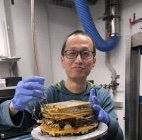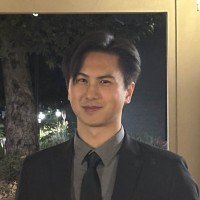Research Group
At Caltech, I lead a small research group consisting of postdocs, visiting graduate students, summer under-graduate students, and sometimes high-school students. We are interested in understanding the formation and evolution of galaxies across cosmic time, applying observations, simulations, and machine learning methods. For a broad overview of science, see the research overview.
In addition, I am leading the Extragalactic and Early-Universe Group (EEG). EEG connects students, postdocs, and staff at Caltech/IPAC who are actively working on extragalactic astrophysics (especially higher redshifts). We also frequently host guests (as here D. Schaerer and R. Chaves from the University of Geneva, Switzerland)!
Postdocs

Dr. Yu-Heng Lin
(2023 - present)
Yu-Heng is working on HST slit-less grism spectroscopy of high redshift low-luminosity quasars. The goal is to confirm their redshifts (thus setting important constraints on the faint-end of the quasar luminosity function) and probe their environment.
LinkedIn
Dr. Wuji Wang
(2024 - present)
Wuji uses JWST/NIRCam and NIRSpec/IFU observations to study the chemical properties of the circum-galactic medium of galaxies and AGN as part of the ALPINE-CRISTAL-JWST/IFU program. Using JWST/MIRI spectroscopy, he is also contributing to the first spatial-resolved study of Polycyclic Aromatic Hydrocarbons (dust molecules) in galaxies 7 billion years ago.
WebpageTBD
(starting 2025)
My group is looking for a postdoc to work on implementing a tool to extract the photometry and spectroscopy of gravitational lenses in Euclid. Let me know if you are interested!
Learn More!Past Postdocs:
- Dr. Marziye Jafariyazani (2021 - 2024) worked on understanding quiescent galaxies at cosmic noon with JWST and machine learning algorithms.
(Visiting) Graduate Students

Karina Barboza
(2025 - present)
Karina studies the dusty early universe with a joint analysis of JWST and the CHAMPS ALMA large program on the COSMOS field.
Webpage
Lun-Jun (Simon) Liu
(2025 - present)
Simon is a graduates student at Caltech and studies singly ionized Carbon halos ("[CII]-halos") around galaxies in the early Universe within cosmological simulations.
Google ScholarTBD
(starting 2026)
Caltech/IPAC offers competitive visiting graduate student fellowships. Apply and get funding to study in my group for 6 months (usually from February to August).
Learn More!Past (Visiting) Graduate Students:
- Patrizia Bussatori (co-mentoring, 2022 - 2023, University Padova, Italy) studied the properties of star forming clumps in ALPINE galaxies by combining ALMA and JWST imaging from COSMOS-Web.
- Brittany Vanderhoof (co-mentoring, 2020 - 2022, Rochester Institute of Technology) studied the interstellar medium properties of galaxies at a redshift of z=4.5 by a joint analysis of their optical [OII] emission and far-infrared properties observed with ALMA. Vanderhoof et al. (2022)
- Yoshinobu Fudamoto (visiting student, 2019, University of Geneva) studied the fraction of dust obscured star formation in galaxies at redshifts z=4-5 from the ALPINE survey. is studying the interstellar medium properties of galaxies at a redshift of z=4.5 by a joint analysis of their optical [OII] emission and far-infrared properties observed with ALMA. Fudamoto et al. (2020)
- Thomas Venville (visiting student, 2019, Univ. Swinburne / Caltech) build a framework to identify transient and variable sources with machine learning. Venville et al. (2024)
- Rebecca Larson (visiting student, 2018, Univ. Texas) used the fact that galaxies cluster differently to estimate the redshift of galaxy samples. "Clustering redshifts" provide a complementary method to photometric redshifts and will be useful to the next generation of wide-field surveys carried out with Roman or Euclid. (Publication in Preparation)
Undergraduate Students

Edward Zhang
(2023 - present)
For a period of 10 weeks, Edward studied how SPHEREx will measure the dust properties of low-redshift galaxies through their PAH emission. He just submitted his first publication on this project!
Learn More!TBD
(starting 2025)
Caltech offers the Summer Undergraduate Research Fellowship (SURF) every year. SURFs can pursue research at Caltech for 10 weeks in summer on an attractive stipend. Look out for projects posted by myself or collaborators.
Learn More!Past Undergraduate Students:
- Sage Santomenna (2024, Pomona College, SURF) searched for high-redshift quasars in the Epoch of Reionization via a joint analysis of Euclid and Subaru data. Thereby he reduced all available Subaru data on the Euclid early release fields.
- Vaennessa Nickell (2024, Caltech, SURF) analyzed the optical and infrared properties of variable ZTF (optical) and WISE (infrared) AGN.
- Teresa Huang (2021, Caltech, SURF) is using covision machine learning techniques to identify stars on images. The identification of stars is important to cross-align images taken by different facilities, remove contamination from galaxy samples, and measure stellar streams through their propert motion on the sky. These concepts will play a major role in wide-field surveys undertaken by the next generation of telescopes.
- Ishita Korde (2019, UC Riverside, Computer Science, FIELDS) wrote a program to measure emission lines from spectra taken in the COSMOS field. A large catalog of complete line measurements can be used for the calibration of simulations that predict the numbers of such galaxies to be observed with the Euclid and the Roman space telescope.
- Catalina Miritescu (2016, Caltech, SURF) studied the depeof strong optical [OIII] emission and the escape fraction of UV photons in galaxies at redshifts of z=1. For this, she measured [OII] and [OIII] emission for galaxies in the COSMOS field. High [OIII]/[OII] ratios characterize galaxies in the early Universe - the study of similar galaxies at low redshifts can therefore give us clues on the physics of the first galaxies.
- Ivana Barisic (2015, Univ. of Zagreb / Caltech, SURF) studied the dust properties of galaxies at z=6 with ALMA and the Hubble Space Telescope. Barisic et al. (2017)
Highschool Students
Emily Chien
(2025 - present)
Emily measures light profiles of massive galaxies in public Euclid data to constrain their formation.
Learn More!Past Highschool Students:
- ...